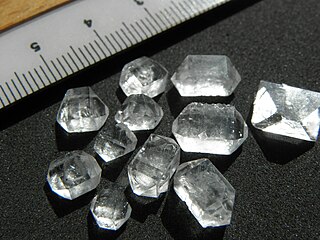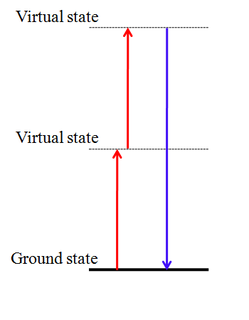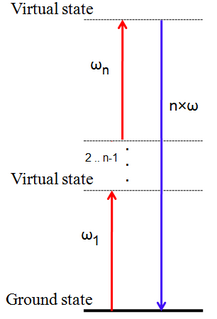
A laser is a device that emits light through a process of optical amplification based on the stimulated emission of electromagnetic radiation. The word "laser" is an acronym for "light amplification by stimulated emission of radiation". The first laser was built in 1960 by Theodore H. Maiman at Hughes Research Laboratories, based on theoretical work by Charles Hard Townes and Arthur Leonard Schawlow.

Nonlinear optics (NLO) is the branch of optics that describes the behaviour of light in nonlinear media, that is, media in which the polarization density P responds non-linearly to the electric field E of the light. The non-linearity is typically observed only at very high light intensities (values of atomic electric fields, typically 108 V/m) such as those provided by lasers. Above the Schwinger limit, the vacuum itself is expected to become nonlinear. In nonlinear optics, the superposition principle no longer holds.

Spontaneous parametric down-conversion is a nonlinear instant optical process that converts one photon of higher energy, into a pair of photons of lower energy, in accordance with the law of conservation of energy and law of conservation of momentum. It is an important process in quantum optics, for the generation of entangled photon pairs, and of single photons.
An optical parametric amplifier, abbreviated OPA, is a laser light source that emits light of variable wavelengths by an optical parametric amplification process. It is essentially the same as an optical parametric oscillator, but without the optical cavity.

Photodetectors, also called photosensors, are sensors of light or other electromagnetic radiation. There is a wide variety of photodetectors which may be classified by mechanism of detection, such as photoelectric or photochemical effects, or by various performance metrics, such as spectral response. Semiconductor-based photodetectors typically have a p–n junction that converts light photons into current. The absorbed photons make electron–hole pairs in the depletion region. Photodiodes and phototransistors are a few examples of photodetectors. Solar cells convert some of the light energy absorbed into electrical energy.
Four-wave mixing (FWM) is an intermodulation phenomenon in non-linear optics, whereby interactions between two or three wavelengths produce two or one new wavelengths. It is similar to the third-order intercept point in electrical systems. Four-wave mixing can be compared to the intermodulation distortion in standard electrical systems. It is a parametric nonlinear process, in that the energy of the incoming photons is conserved. FWM is a phase-sensitive process, in that the efficiency of the process is strongly affected by phase matching conditions.

Monopotassium phosphate (MKP) (also, potassium dihydrogenphosphate, KDP, or monobasic potassium phosphate) is the inorganic compound with the formula KH2PO4. Together with dipotassium phosphate (K2HPO4.(H2O)x) it is often used as a fertilizer, food additive, and buffering agent. The salt often cocrystallizes with the dipotassium salt as well as with phosphoric acid.

Potassium titanyl phosphate (KTP) is an inorganic compound with the formula KTiOPO4. It is a white solid. KTP is an important nonlinear optical material that is commonly used for frequency-doubling diode-pumped solid-state lasers such as Nd:YAG and other neodymium-doped lasers.

The Shiva laser was a powerful 20-beam infrared neodymium glass laser built at Lawrence Livermore National Laboratory in 1977 for the study of inertial confinement fusion (ICF) and long-scale-length laser-plasma interactions. Presumably, the device was named after the multi-armed form of the Hindu god Shiva, due to the laser's multi-beamed structure. Shiva was instrumental in demonstrating a particular problem in compressing targets with lasers, leading to a major new device being constructed to address these problems, the Nova laser.

Nova was a high-power laser built at the Lawrence Livermore National Laboratory (LLNL) in California, United States, in 1984 which conducted advanced inertial confinement fusion (ICF) experiments until its dismantling in 1999. Nova was the first ICF experiment built with the intention of reaching "ignition", a chain reaction of nuclear fusion that releases a large amount of energy. Although Nova failed in this goal, the data it generated clearly defined the problem as being mostly a result of Rayleigh–Taylor instability, leading to the design of the National Ignition Facility, Nova's successor. Nova also generated considerable amounts of data on high-density matter physics, regardless of the lack of ignition, which is useful both in fusion power and nuclear weapons research.
Ultrafast laser spectroscopy is a spectroscopic technique that uses ultrashort pulse lasers for the study of dynamics on extremely short time scales. Different methods are used to examine the dynamics of charge carriers, atoms, and molecules. Many different procedures have been developed spanning different time scales and photon energy ranges; some common methods are listed below.

Resonance-enhanced multiphoton ionization (REMPI) is a technique applied to the spectroscopy of atoms and small molecules. In practice, a tunable laser can be used to access an excited intermediate state. The selection rules associated with a two-photon or other multiphoton photoabsorption are different from the selection rules for a single photon transition. The REMPI technique typically involves a resonant single or multiple photon absorption to an electronically excited intermediate state followed by another photon which ionizes the atom or molecule. The light intensity to achieve a typical multiphoton transition is generally significantly larger than the light intensity to achieve a single photon photoabsorption. Because of this, a subsequent photoabsorption is often very likely. An ion and a free electron will result if the photons have imparted enough energy to exceed the ionization threshold energy of the system. In many cases, REMPI provides spectroscopic information that can be unavailable to single photon spectroscopic methods, for example rotational structure in molecules is easily seen with this technique.
Sum-frequency generation (SFG) is a second order nonlinear optical process based on the annihilation of two input photons at angular frequencies and while, simultaneously, one photon at frequency is generated. As with any second order phenomenon in nonlinear optics, this can only occur under conditions where: the light is interacting with matter, which is asymmetric ; the light has a very high intensity . Sum-frequency generation is a "parametric process", meaning that the photons satisfy energy conservation, leaving the matter unchanged:

Second-harmonic generation is a nonlinear optical process in which two photons with the same frequency interact with a nonlinear material, are "combined", and generate a new photon with twice the energy of the initial photons, that conserves the coherence of the excitation. It is a special case of sum-frequency generation, and more generally of harmonic generation.
The High Power laser Energy Research facility (HiPER), is a proposed experimental laser-driven inertial confinement fusion (ICF) device undergoing preliminary design for possible construction in the European Union. As of 2019, the effort appears to be inactive.

Harmonic generation is a nonlinear optical process in which photons with the same frequency interact with a nonlinear material, are "combined", and generate a new photon with times the energy of the initial photons.

Electro-optic rectification (EOR), also referred to as optical rectification, is a non-linear optical process that consists of the generation of a quasi-DC polarization in a non-linear medium at the passage of an intense optical beam. For typical intensities, optical rectification is a second-order phenomenon which is based on the inverse process of the electro-optic effect. It was reported for the first time in 1962, when radiation from a ruby laser was transmitted through potassium dihydrogen phosphate (KDP) and potassium dideuterium phosphate (KDdP) crystals.

Deuterated potassium dihydrogen phosphate (KD2PO4) or DKDP single crystals are widely used in non-linear optics as the second, third and fourth harmonic generators for Nd:YAG and Nd:YLF lasers. They are also found in electro-optical applications as Q-switches for Nd:YAG, Nd:YLF, Alexandrite and Ti-sapphire lasers, as well as for Pockels cells.
A parametric process is an optical process in which light interacts with matter in such a way as to leave the quantum state of the material unchanged. As a direct consequence of this there can be no net transfer of energy, momentum, or angular momentum between the optical field and the physical system. In contrast a non-parametric process is a process in which any part of the quantum state of the system changes.
Wide-field multiphoton microscopy refers to an optical non-linear imaging technique tailored for ultrafast imaging in which a large area of the object is illuminated and imaged without the need for scanning. High intensities are required to induce non-linear optical processes such as two-photon fluorescence or second harmonic generation. In scanning multiphoton microscopes the high intensities are achieved by tightly focusing the light, and the image is obtained by beam scanning. In wide-field multiphoton microscopy the high intensities are best achieved using an optically amplified pulsed laser source to attain a large field of view (~100 µm). The image in this case is obtained as a single frame with a CCD without the need of scanning, making the technique particularly useful to visualize dynamic processes simultaneously across the object of interest. With wide-field multiphoton microscopy the frame rate can be increased up to a 1000-fold compared to multiphoton scanning microscopy. Wide-field multiphoton microscopes are not yet commercially available, but working prototypes exist in several optics laboratories.












